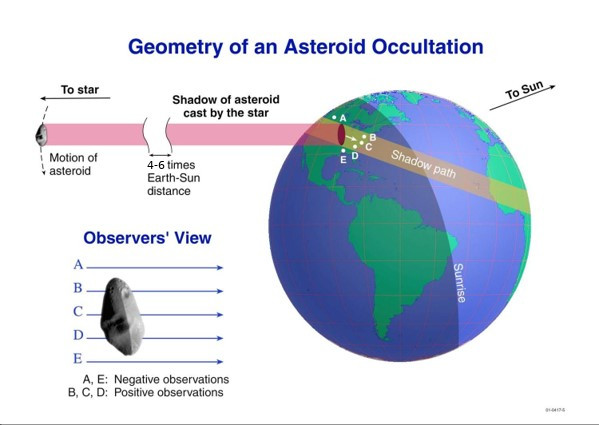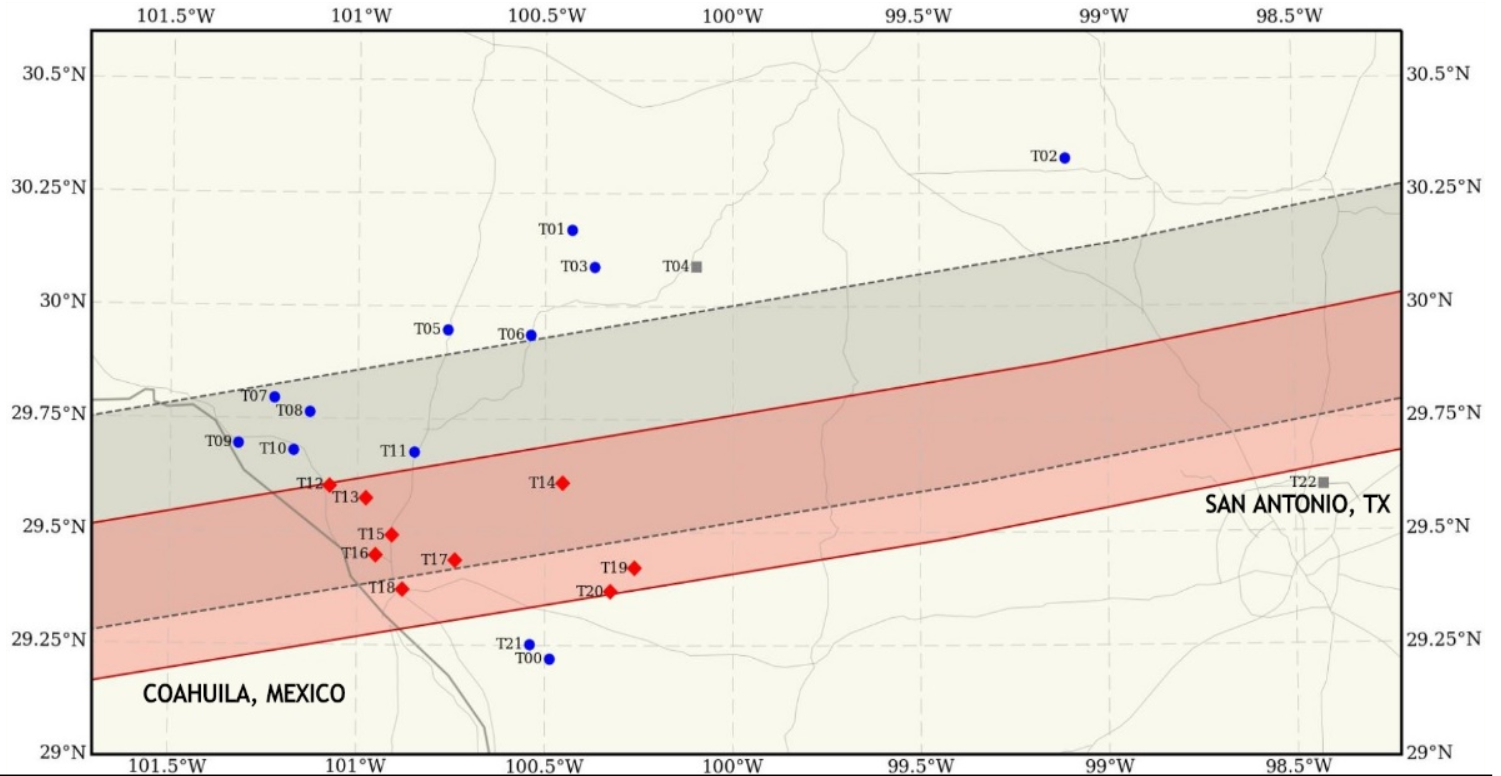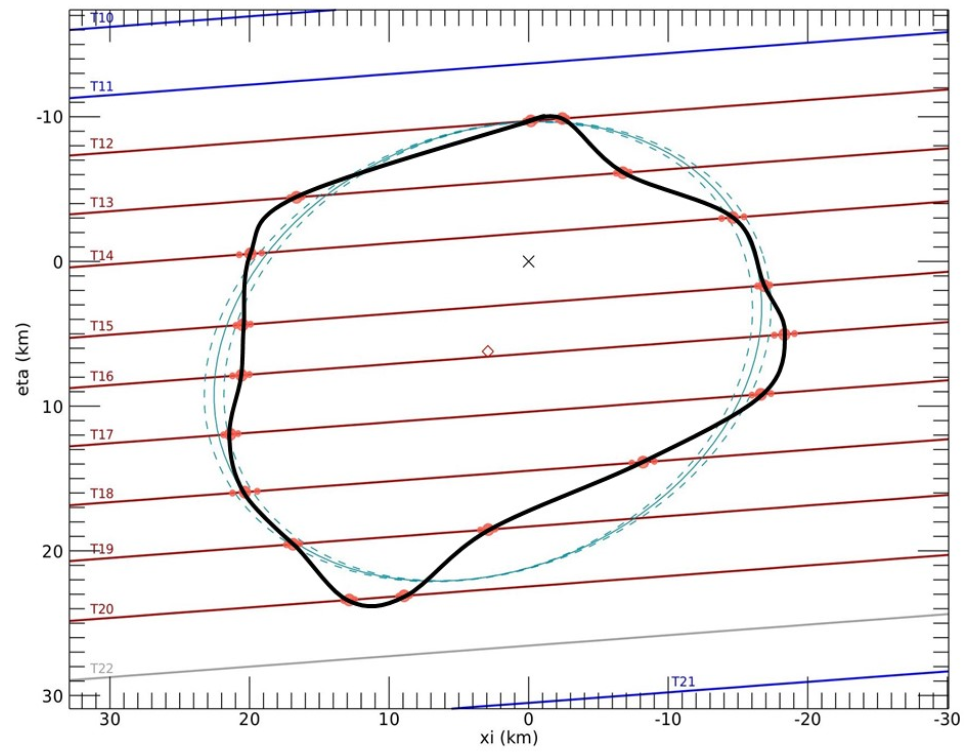Chasing an Asteroid’s Shadow
Mar 17, 2021
By David Dezell Turner, Lucy Intern
Every so often, a Trojan asteroid, orbiting roughly 800 million km (500 million miles) from the Sun, briefly passes in front of a star on the order of 30,000 trillion km, or 20,000 trillion miles, away. For a few seconds, as the Earth, asteroid and star perfectly align, the asteroid casts a shadow on the Earth. This phenomenon is called an occultation. Occultations are particularly important for the Lucy Mission, since finding and measuring shadows cast by asteroids means pinning down the positions of the asteroids before the spacecraft approaches them. In few other contexts can astronomers measure the positions of astronomical objects with this degree of precision from Earth, which is why teams of astronomers travel all over the planet for the chance to stand in the shadows of asteroids.

One of these astronomers is Brian Keeney, an Observing and Logistics Specialist for the Lucy Mission. Keeney has been a professional astronomer for 20 years, spending the last three of those years observing occultations. “I think that being part of these [occultation] campaigns has been the most satisfying and adventurous thing I’ve ever [done] as a professional astronomer,” he explains. Working with teams that run the gamut of astronomy skill levels, from professional astronomers to high school students, Keeney has chased the shadows of space rocks around the world, including to Argentina, Australia, and Senegal.
During an occultation, the asteroid blocks a star so distant that the shadow cast on the Earth’s surface is extremely close to the size of the asteroid itself. We cannot choose where the shadow will fall, so teams of astronomers often have to travel to the locations where the shadow is predicted to be. The goal is for the observing teams to spread out in the predicted shadow region, then aim their telescopes at the star being occulted. If all goes according to plan, they will record the moment when the asteroid passes in front of the star; from their perspective, this will look like the star has briefly disappeared, as though someone turned it off for a few seconds. They can then measure exactly when and for how long the star is hidden from view. Not only does this data help astronomers determine the asteroid’s location with incredible precision, but they can also use it to estimate the size and shape of the asteroid’s shadow, and thus the size and shape of the asteroid itself.
In reality, the process is easier explained than done. To plan an occultation campaign, astronomers must first accurately predict the location of the asteroid’s shadow, which requires precise knowledge of the position of the star and the orbit of the asteroid. Until recently, occultation predictions often had uncertainties of hundreds of kilometers, Keeney recalls. This meant that astronomers attempting to view an occultation by a 20 km (10 mi) object (like Polymele, Lucy’s smallest Trojan target) often had to spread out over a distance on the order of 300 km (190 mi) in hopes that some of them might see it. All of this changed when the European Space Agency released the data collected by their star-mapping Gaia satellite. Gaia was launched in 2013, and by 2018, it had catalogued the position and brightness of 1.7 billion stars. “We knew when the Gaia catalogue became available that the uncertainties in the stellar positions were so much smaller,” Keeney continues. “We knew that this should be a game-changer. With this new information… instead of being uncertain by 100 km, now we’re uncertain by 10 km.” Astronomers trying to view the same 20 km (10 mi) object today would only have to cover about 50 km (30 mi). There is still no way to determine exactly which team members will see the occultation and which will end up outside of the shadow, but thanks to Gaia’s unprecedented level of precision, occultation campaigns are much more efficient and can gather useful data for space missions. Also, each occultation teaches the Lucy team more about each asteroid’s orbit, improving the accuracy of each subsequent prediction. Even if some observers end up outside the shadow, their negative observations can be just as helpful as positive ones.

Even with the most accurate predictions, however, unforeseen obstacles can still arise. On November 18, 2018, the Lucy team was in Texas preparing to observe an occultation by asteroid Leucus that would occur that night. They had been using the Southwest Research Institute’s San Antonio campus as a place to meet up, hand out equipment (such as telescopes, laptops, and astronomical cameras), and hold practice sessions. Each of the 23 observation teams made sure to choose a location within the predicted path before the big day. That morning, however, Brian Keeney and Marc Buie (the mission’s Satellites and Rings Working Group Lead) noticed a glitch in their prediction software that had gone undetected for the entire campaign. This glitch shifted the timing of the occultation prediction by about 30 seconds, which erroneously put the predicted path south of San Antonio. The two realized that if they didn’t travel north, they would miss the occultation. The weather in the San Antonio area was getting worse, however, so if they traveled directly north or east, they would be caught in a rainstorm! “We talked to the teams right after breakfast that morning, right after we convinced ourselves we were right,” Keeney remembers. “We just said, ‘Hey. Guess what, guys? Sorry, but we need to go north. And not just north, because the weather’s going to be bad here. We need to go north and as far west as possible.’” Each team scouted locations within the new predicted path, found areas with the least cloud cover, and pointed their telescopes at the star when the time came. Due to everyone’s quick thinking and adaptability, nine teams were able to see the occultation, and almost all teams walked away with amazing data.

One of the most exciting aspects of occultations is the fact that with practice and the right equipment, anyone can collect data for a space mission, regardless of experience level. IOTA, the International Occultation Timing Association, is an organization dedicated to supporting the occultation observation efforts of both professionals and amateurs, encouraging “[a]mateur astronomers at all levels of experience… to become ‘citizen-scientists.’” One project supported by IOTA is led by Marc Buie and fellow planetary scientist John Keller. This project, called RECON (Research and Education Collaborative Occultation Network), is a network of amateur astronomers, teachers, high school students, and other community members spread out across the Western United States. RECON aided in the Lucy team’s observation of a Leucus occultation on October 2, 2019. Though RECON was intended to be a stationary network, many teams were more than willing to travel long distances for the event. Some teams helped transport equipment and other observers from their hometowns, and some, like one team from Sisters High School in Sisters, OR, even stayed in the occultation area overnight.
The COVID-19 pandemic has presented new challenges for the occultation team. On September 24, 2020, the team planned to observe an occultation by Polymele in Senegal. Learning about Polymele is especially important for the Lucy team because, as it is the smallest Trojan target, it will be the most challenging to observe during the high speed encounter. The more the team knows about it ahead of time the better. Unfortunately, due to the pandemic, travelling to Senegal was impossible. Fortunately, sending equipment was still feasible. This equipment was lent to a group of Senegalese astronomers with whom Keeney has worked before; on August 4, 2018, they aided NASA’s New Horizons mission in observing an occultation by the Kuiper Belt object Arrokoth, which helped the New Horizons team to better understand the object before the spacecraft’s flyby. Organizing an occultation campaign on the other side of the world without being able to travel there was fairly new territory for the Lucy team, but this is the culmination of lessons learned over several occultation campaigns. During their earliest campaigns, the Lucy team relied on the same 40-cm (16-inch) diameter telescopes New Horizons used for the Arrokoth occultation, which are heavy and require two or three people to set up. Now, the team deploys much lighter 20-cm (8-inch) telescopes whenever possible. For that Senegal occultation, the team sent a set of these smaller telescopes, since the star being occulted is so bright that the larger telescopes are not necessary. On the logistical side, the team is also drew from their experience planning a campaign in Phoenix, Arizona on December 29, 2019, for which Keeney himself drove equipment from Boulder, Colorado and lent it to local astronomers. That event involved teams from both IOTA and RECON, and though it had less direct oversight from the Lucy team than most, nearly all of the teams involved were able to collect good data. “The Phoenix event was kind of a scaled down version of what we did for Senegal in that for the most part, teams were much more independent and on their own until the very last minute…. It was new, and it’s different, but I expect that if we hadn’t tried the event in Phoenix in December, we wouldn’t have had the confidence to do the Senegal event.”

On September 24, 2020, Polymele racing by at 50,000 kph (31,000 mph) — crossed in front of a star. Unfortunately, at that precise moment, the skies over much of Sengal was covered with patchy clouds. One lucky observer had a fortuitous break in the clouds and was able to observe a single star wink out for less than two seconds. While this single observation was not enough to really pin down the dimensions of this small asteroids, it did add new constraints to the size and showed the scientists the location of the asteroid with unprecedented precision.
Fortunately that was not the last opportunity to observe Polymele. This fall, observers in Spain will have a chance to see Polymele is cross in front of another star. Again, we don’t know if COVID-19 will allow international travel, but based on these previous experiences the team is confident that at least the Lucy telescopes will make their way across the Atlantic ocean to attempt to view this occultation. With the data gathered from that single observation last year, Buie and Keeney can predict where this occultation track will fall with incredible accuracy, allowing the observers to be more tightly clustered on the ground. If the weather cooperates, this will give amazing data on the size, and shape of this small asteroid. With these precise predictions and a little luck, a group of astronomers will be fortunate enough to find themselves standing in this asteroid’s shadow.
You can see a list of upcoming occultations of Lucy Targets here. If you’d like to learn more or get involved, the best way is to reach out to your local IOTA chapter.
Banner Image: Julien Salmon during a dress rehearsal for the Orus occultation. Credit: Mike Grusin